We may earn commissions when you buy from links on our site. Why you can trust us.
Review of the Breville Smart Oven Convection Toaster
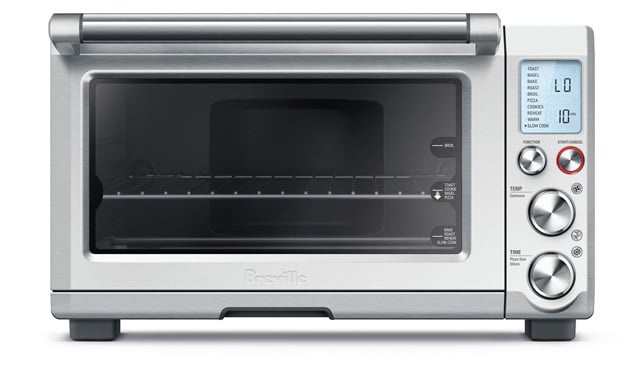
[Editor's Note: Some of this content is taken directly from our Best Toaster Oven review article]
We recently reviewed four of the top toaster convection ovens to determine which was truly the best: the Breville Smart Oven Plus #BOV810BSS ($250 on Breville.com), the Cuisinart Chef’s Convection Toaster Oven #TOB-260N ($235.45 on Amazon), the Hamilton Beach Set & Forget Toaster Oven #31230 ($89.99 on Amazon) and the Kenmore Elite Digital Countertop Convection Oven #0876771 ($149.99 on Kenmore.com and through Sears). Our top pick was the Cuisinart Chef’s Convection Toaster Oven for its excellent cooking results, food capacity and convenience features. However, the Breville was close on its heels. And for those with a little less countertop space, it may be the better choice.
Comparison of Breville Smart Oven models
Breville has three models in its full-size Smart Oven line: the Smart Oven (BOV800XL), the Smart Oven Plus (BOV810BSS) and the Smart Oven Pro (BOV845BSS). Each model has the exact same dimensions, design and cooking technology. The Smart Oven Plus adds a slow cooking feature that lets you cook for up to 10 hours before automatically turning to a keep warm mode. The Smart Oven Pro has the slow cooking feature and an interior oven light.
The Smart Oven is available on Amazon and multiple other outlets for $249.99. The Smart Oven Plus is a William Sonoma exclusive for $249.95. And the Smart Oven Pro is $269.95 through Amazon and other sources.
Our review was done with the Smart Oven Plus. However, the results would apply equally to any of the three models. We didn't test the slow cooking feature as it seemed unlikely that most owners would make use of it and, frankly, we felt a little uncomfortable leaving a hot toaster unattended for 6-10 hours at a time. But based on the overall performance of the Breville, there's no reason to suspect that the slow cooking feature wouldn't perform as expected.
Cooking capacity
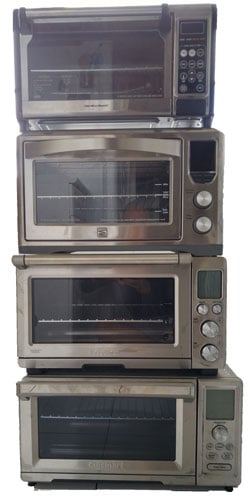
From top: Hamilton Beach, Kenmore, Breville & Cuisinart
Each model we tested could fit our 3-lb chickens and 12-inch pizzas without issue.
The Cuisinart Chef’s Convection Toaster Oven offered the most interior capacity of .95 cubic feet, while the Breville Smart Oven was about 20% smaller (.8 cubic feet). In practice, this didn't make much difference with any of our tests. However, the Cuisinart is large enough that it can actually cook with two interior racks, a nice bonus.
The trade-off for that extra capacity is less counter space. The Breville dimensions are 18.5 inches wide vs 20 inches for the Cuisinart, and 15.75 inches deep vs 17 inches. The Breville is a little shorter, too, at 11 inches vs 12 inches.
Cooking performance
Toasting performance
Any device that includes “toaster” in its name should be able to toast; not something that many toasters live up to, sadly. We were looking for six slices of toast that were evenly cooked no matter where on the rack they were in and had the same level of toastiness on the bottom. So, we popped the slices in, set each toaster to “Medium” and let them go. The Breville also offers a “bagel mode”, which lets you brown just the top part of your bagel or English muffin.
Here's how the Breville performed versus the other models.
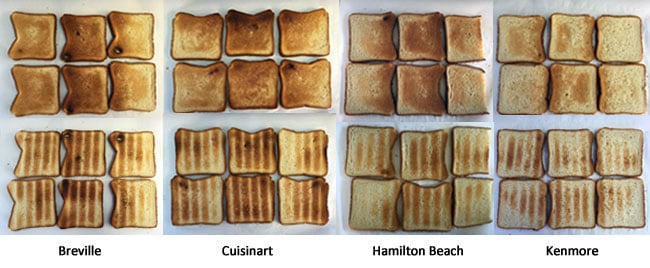
Interestingly, we found that toasting evenness has a lot more to do with your bread than your toaster. As you can see in the comparison shot, the top of the slice was consistently more toasted than the bottom, regardless of toaster or orientation. We presume this is due to lower moisture levels at the top of the loaf.
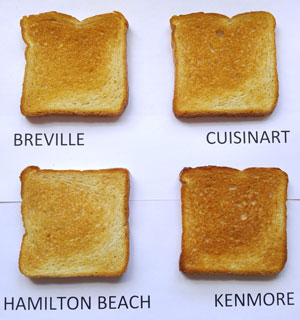
Next, we wanted to test out toasting speed. After all, no one wants to sit around in the morning waiting for their toast to get done. We let each model go for 4 minutes then pulled out the bread to evaluate the level of toastiness.
We found that the Kenmore provided the most toasting, just ahead of the Cuisinart and Breville.
Cooking frozen pizza
We tested each of the ovens on a frozen 12-inch pizza using their pre-defined “pizza modes”, when available, or else followed the directions on the pizza box. Two of the ovens, the Cuisinart and the Kenmore, come with pizza stones included in the box. However, both stones arrived broken, so it's hard to count this as a "feature". Buying your own stone with the Breville, if desired, may be less trying on your sanity.
The results were clear that those ovens that cooked slowest, the Kenmore and the Hamilton Beach, also cooked the most evenly. The Cuisinart, which cranked out the pizza a few minutes faster than the others, was the least even. The Breville was close behind the leaders.

That being said, we're actually calling this one a tie, because the pizza modes on any of the ovens can be customized to cook at whatever temperature you want (you don't need to stick with the factory preset). It’s a simple matter to dial down the Breville to cook slightly slower. And our six-person taste test (including three hungry kids), found that all the pizzas tasted pretty much the same, regardless of how even they appeared on top.
Roasting chicken
Cooking pizzas is fine, and all that, but to really be an “oven” the contenders needed to prove their worth as a true substitute or backup for the full-sized oven in our kitchen. So we went with the standard dish that every oven needs to be able to nail—roasting a chicken.
We used four identical 3.5-pound birds for our test. The birds were seasoned with salt and herbs and popped in the ovens to convection cook at 400F until our thigh temperature measurements were at 160F using a Thermopen. The Hamilton Beach includes a built-in temperature probe, so we stuck that in the chicken and set it to 160F, as well (at which point the oven beeps and shut off).
All four of the ovens did a surprisingly good job with the birds - better, actually, than our non-convection standard kitchen range. But the Cuisinart Chef’s Convection Toaster Oven was the runaway winner here. Its “Speed Convection” mode delivered the fastest cooking time, evenly cooked meat and, most importantly, beautifully browned skin. The Breville, again, was in second place behind the Cuisinart. While Kenmore was the slowest of the lot, taking 10 minutes longer than the Cuisinart to fully cook the bird. And the small Hamilton Beach produced chicken that was paler on the sides than the others. Its temperature probe was useful, but still required double checking with our Thermopen to make sure that there weren't underdone areas.

Baking cookies
What better way to finish off our testing than with trays of freshly-baked chocolate chip cookies? We used store-bought dough (hey, this is a toaster oven review, not a cooking class!) and baked at 350F for 12 minutes.
The slower cooking Kenmore delivered the most even browned cookies, followed closely by the Breville, but the Cuisinart and Hamilton Beach weren't far behind.
Controls & Display
The Breville Smart Oven Plus uses a combination of knobs and buttons to set the various cooking modes and temperatures. If it all sounds confusing, it is. But after a few times through you get the hang of it. And, once you have your cooking presets set the way you want them (e.g., you can dial down the temperature for Pizza mode or turn off convection for Cookies), the process is pretty easy. The Breville's control knob had a higher quality feel to it than the Cuisinart, which felt surprisingly cheap, given its higher price.
The Breville has a clock on its display to remind you that you're late for work.
Safety
With their small door openings and hot metal surfaces, both inside and out, we considered the safety of my toaster oven to be an important consideration. This is especially true for families where children use the toaster oven frequently to make toast and reheat pizza.
In this department, the Breville and Cuisinart again stood out from the less expensive contenders. Both have catches on the doors (magnetic for the Breville and a hook for the Cuisinart) that will automatically pull out the cooking rack – no need to reach in to grab your hot trays. Each also has a safety catch on the main rack level to prevent the rack from sliding out all the way. The Kenmore won’t pull the rack out automatically, but it, too, has a safety catch. The Hamilton Beach has neither auto pull out nor a safety catch, making it the most dangerous of the lineup; on more than one occasion, we accidentally pulled out the entire rack, and then scrambled to keep a burning hot rack of food from sliding onto the floor.
Our tested model, the Smart Oven Plus, does not come with an interior light. However, the slightly more expensive Smart Oven Pro does. I don't think a light is really necessary for a toaster oven, so up to you if you want to pay $20 more to get it.
User Reviews
The Cuisinart tops the charts with a very strong 4.8 out of 5 star rating on Amazon and no major complaints. The Breville Smart Oven line does pretty well, too, with 4.5 out of 5 stars on Amazon, though there were some issues with units dying shortly after warranty and poor customer service. The reviews for the Smart Oven Plus on William Sonoma were similar, with strong reviews overall, but a not insignificant number of people complaining about falling units. That's a little bit of a concern because the Breville comes with only a 1-year warranty versus 3 years for the Cuisinart.
Overall recommendation for the Breville Smart Oven
The Breville Smart Oven Plus (and the other models in the line) is an excellent oven that performed well across the board. It offers enough food capacity to make it a viable substitute for your full-sized home oven. It missed being our top pick to the Cuisinart due to its smaller interior capacity (.8 cubic feet vs the Cuisinart’s .95), lower user ratings and shorter warranty. For those looking for a slightly smaller model (or who value a slow cooker function), the Breville would be an excellent alternative to the Cuisinart.
When choosing which Breville model to get, the Smart Oven Plus offers the best value—it's the same price as the Smart Oven but includes the Slow Cooking feature (though only available through William Sonoma). If you want a light for not much more, go with the Smart Oven Pro.
Breville Smart Oven/Smart Oven Plus/Smart Oven Pro
Image Credits: Breville, Techlicious
Discussion 
I purchased this oven and it would not work in my house. Called Breville and they said I needed a separate circuit for this oven. There is no information on the box or on line about this problem. I am not going to rewire my kitchen so that I can use this oven. I guess I will continue to use my old Breville toaster oven, now I have to go to the trouble of returning this new oven.
Very disappointed with the response from Breville rep.
It is certainly possible that if you have too many items, especially a large appliance, on that same circuit, you may have issues. That could be true with any large toaster oven. However, the Breville doesn’t require its own circuit. We ran it on a shared circuit without issue.
Did you try the Breville on another circuit to narrow down whether it was really a power issue on that line or an issue with the oven, itself?
I tried this oven in different areas and it didn’t work. I am returning the oven for a refund. I am a handicapped 84 year old, and it is too difficult for me to try another oven and may still have a problem.
Very sorry that Breville cannot list this requirement on the outside of the box where people can see this before making the purchase.
The Breville toaster at 1800 Watts requires about 15 amps of power at full load. There is no requirement to have it run on a dedicated circuit, but if you have other items running on that same circuit you may have issues. Any large toaster oven, not just Breville, will have the same issue to varying degrees depending on how much power it uses.
However, given that you couldn’t get this oven to work in any area of your house indicates that this is an issue with the oven itself or how you’re using it. I would return it and perhaps go with a smaller/lower-wattage model if you don’t want to try with another Breville Smart Oven Plus.
Oven B650 was purchase on 2011, does not work since day 1 and stored in the closet, upon findings by an EE degree friend, Part# SP0010487 sensor assembly require replacement(this part breaks after time), part was discontinue but the product is still available for sale, this is definitely a consumer fraud. Buyers Beware, look for products with replacement parts.
PS B800 series sensor assembly are also unavailable (not discontinue, good luck waiting).

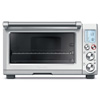

















From Rami Khalil Daoud on April 02, 2018 :: 4:21 pm
The World minus NorthAmerica cannot operate Breville Smart Oven Air without a step-down transformer!!!!!
Reply